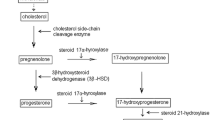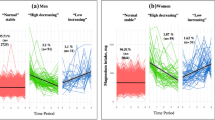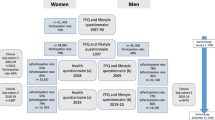Abstract
Background
Cortisol within the normal range has been associated with reduced bone density in the elderly, but little is known about this relationship in healthy young women.
Purpose
The purpose of this study is to assess whether 24-h urinary free cortisol excretion (UFC) is related to bone density in 132 healthy, non-obese, regularly menstruating women, aged 19–35.
Method
Participants completed questionnaires (food frequency, demographics, physical activity, dietary restraint, perceived stress, and daily stress) and a 24-h urine collection. UFC was determined by high-throughput liquid chromatography and tandem mass spectrometry. Anthropometrics were completed and a dual energy X-ray absorptiometry scan measured areal bone mineral density (aBMD, g/cm2) and bone mineral content (BMC, g) at the lumbar spine (L1–4), hip, and total body (TB) as well as total body lean (LBM) and fat mass.
Results
aBMD and BMC were significantly positively associated with height, LBM, physical activity, calcium intake, and duration of previous oral contraceptive use (except L1–4) and negatively with perceived stress. UFC was not correlated with any measured variables except urine volume (r = 0.17, p = 0.046). After adjusting for urine volume, height, LBM, ethnicity, and prior oral contraceptive use, UFC was significantly inversely associated with TB BMC (r = −0.30, p < 0.001) and aBMD (r = −0.27, p = 0.003), L1–4 aBMD (r = −0.19, p = 0.035) and BMC (r = −0.18, p = 0.049), and hip BMC (r = −0.23, p = 0.011). Further adjustment for sport activity, calcium intake and perceived stress did not change these relationships meaningfully except that L1–4 became nonsignificant (p < 0.07).
Conclusion
Cortisol within the normal range appears to have a minor negative influence on bone density in healthy young women.
Similar content being viewed by others
References
McEwen BS. Central effects of stress hormones in health and disease: understanding the protective and damaging effects of stress and stress mediators. Eur J Pharmacol. 2008;583:174–85.
Chiodini I, Torlontano M, Carnevale V, Trischitta V, Scillitani A. Skeletal involvement in adult patients with endogenous hypercortisolism. J Endocrinol Invest. 2008;31:267–76.
Cetin A, Gokce-Kutsal Y, Celiker R. Predictors of bone mineral density in healthy males. Rheumatol Int. 2001;21:85–8.
Dennison E, Hindmarsh P, Fall C, Kellingray S, Barker D, Phillips D, et al. Profiles of endogenous circulating cortisol and bone mineral density in healthy elderly men. J Clin Endocrinol Metab. 1999;84:3058–63.
Raff H, Raff JL, Duthie EH, Wilson CR, Sasse EA, Rudman I, et al. Elevated salivary cortisol in the evening in healthy elderly men and women: correlation with bone mineral density. J Gerontol A Biol Sci Med Sci. 1999;54:M479–83.
Reynolds RM, Dennison EM, Walker BR, Syddall HE, Wood PJ, Andrew R, et al. Cortisol secretion and rate of bone loss in a population-based cohort of elderly men and women. Calcif Tissue Int. 2005;77:134–8.
Greendale GA, Unger JB, Rowe JW, Seeman TE. The relation between cortisol excretion and fractures in healthy older people: results from the MacArthur studies. J Am Geriatr Soc. 1999;47:799–803.
Altindag O, Altindag A, Asoglu M, Gunes M, Soran N, Deveci Z. Relation of cortisol levels and bone mineral density among premenopausal women with major depression. Int J Clin Pract. 2007;61:416–20.
Biller BM, Saxe V, Herzog DB, Rosenthal DI, Holzman S, Klibanski A. Mechanisms of osteoporosis in adult and adolescent women with anorexia nervosa. J Clin Endocrinol Metab. 1989;68:548–54.
Kahl KG, Rudolf S, Stoeckelhuber BM, Dibbelt L, Gehl HB, Markhof K, et al. Bone mineral density, markers of bone turnover, and cytokines in young women with borderline personality disorder with and without comorbid major depressive disorder. Am J Psychiatry. 2005;162:168–74.
Legroux-Gerot I, Vignau J, D'Herbomez M, Collier F, Marchandise X, Duquesnoy B, et al. Evaluation of bone loss and its mechanisms in anorexia nervosa. Calcif Tissue Int. 2007;81:174–82.
Misra M, Prabhakaran R, Miller KK, Goldstein MA, Mickley D, Clauss L, et al. Prognostic indicators of changes in bone density measures in adolescent girls with anorexia nervosa-II. J Clin Endocrinol Metab. 2008;93:1292–7.
Naessen S, Carlstrom K, Glant R, Jacobsson H, Hirschberg AL. Bone mineral density in bulimic women—influence of endocrine factors and previous anorexia. Eur J Endocrinol. 2006;155:245–51.
Eskandari F, Martinez PE, Torvik S, Phillips TM, Sternberg EM, Mistry S, et al. Low bone mass in premenopausal women with depression. Arch Intern Med. 2007;167:2329–36.
Petronijevic M, Petronijevic N, Ivkovic M, Stefanovic D, Radonjic N, Glisic B, et al. Low bone mineral density and high bone metabolism turnover in premenopausal women with unipolar depression. Bone. 2008;42:582–90.
Yazici AE, Bagis S, Tot S, Sahin G, Yazici K, Erdogan C. Bone mineral density in premenopausal women with major depression. Joint Bone Spine. 2005;72:540–3.
McLean JA, Barr SI, Prior JC. Dietary restraint, exercise, and bone density in young women: are they related? Med Sci Sports Exerc. 2001;33:1292–6.
Bacon L, Stern JS, Keim NL, Van Loan MD. Low bone mass in premenopausal chronic dieting obese women. Eur J Clin Nutr. 2004;58:966–71.
Nickols-Richardson SM, Beiseigel JM, Gwazdauskas FC. Eating restraint is negatively associated with biomarkers of bone turnover but not measurements of bone mineral density in young women. J Am Diet Assoc. 2006;106:1095–101.
Rideout CA, Linden W, Barr SI. High cognitive dietary restraint is associated with increased cortisol excretion in postmenopausal women. J Gerontol A Biol Sci Med Sci. 2006;61:628–33.
Putterman E, Linden W. Cognitive dietary restraint and cortisol: importance of pervasive concerns with appearance. Appetite. 2006;47:64–76.
Anderson DA, Shapiro JR, Lundgren JD, Spataro LE, Frye CA. Self-reported dietary restraint is associated with elevated levels of salivary cortisol. Appetite. 2002;38:13–7.
Baecke JA, Burema J, Frijters JE. A short questionnaire for the measurement of habitual physical activity in epidemiological studies. Am J Clin Nutr. 1982;36:936–42.
Cohen S, Kamarck T, Mermelstein R. A global measure of perceived stress. J Health Soc Behav. 1983;24:385–96.
Stunkard AJ, Messick S. The Three-Factor Eating Questionnaire to measure dietary restraint, disinhibition and hunger. J Psychosom Res. 1985;29:71–83.
Brantley PJ, Waggoner CD, Jones GN, Rappaport NB. A daily stress inventory: development, reliability, and validity. J Behav Med. 1987;10:61–74.
Csizmadi I, Kahle L, Ullman R, Dawe U, Zimmerman TP, Friedenreich CM, et al. Adaptation and evaluation of the National Cancer Institute's Diet History Questionnaire and nutrient database for Canadian populations. Public Health Nutr. 2007;10:88–96.
Taylor RL, Machacek D, Singh RJ. Validation of a high-throughput liquid chromatography-tandem mass spectrometry method for urinary cortisol and cortisone. Clin Chem. 2002;48:1511–9.
Parry BL, Javeed S, Laughlin GA, Hauger R, Clopton P. Cortisol circadian rhythms during the menstrual cycle and with sleep deprivation in premenstrual dysphoric disorder and normal control subjects. Biol Psychiatry. 2000;1(48):920–31.
Abplanalp JM, Livingston L, Rose RM, Sandwisch D. Cortisol and growth hormone responses to psychological stress during the menstrual cycle. Psychosom Med. 1977;39:158–77.
Bao AM, Ji YF, Van Someren EJ, Hofman MA, Liu RY, Zhou JN. Diurnal rhythms of free estradiol and cortisol during the normal menstrual cycle in women with major depression. Horm Behav. 2004;45:93–102.
Kudielka BM, Kirschbaum C. Awakening cortisol responses are influenced by health status and awakening time but not by menstrual cycle phase. Psychoneuroendocrinology. 2003;28:35–47.
Aedo AR, Landgren BM, Diczfalusy E. Studies on ovarian and adrenal steroids at different phases of the menstrual cycle: II. A comparative assessment of the circadian variation in steroid and lutropin levels during the follicular, periovulatory and luteal phases. Contraception. 1981;23:407–24.
Kneipp SM, Welch DP, Wood CE, Yucha CB, Yarandi H. Psychosocial and physiological stress among women leaving welfare. West J Nurs Res. 2007;29:864–95.
Knowles SR, Nelson EA, Palombo EA. Investigating the role of perceived stress on bacterial flora activity and salivary cortisol secretion: a possible mechanism underlying susceptibility to illness. Biol Psychol. 2008;77:132–7.
Ebrecht M, Hextall J, Kirtley LG, Taylor A, Dyson M, Weinman J. Perceived stress and cortisol levels predict speed of wound healing in healthy male adults. Psychoneuroendocrinology. 2004;29:798–809.
van Eck M, Berkhof H, Nicolson N, Sulon J. The effects of perceived stress, traits, mood states, and stressful daily events on salivary cortisol. Psychosom Med. 1996;58:447–58.
Lasikiewicz N, Hendrickx H, Talbot D, Dye L. Exploration of basal diurnal salivary cortisol profiles in middle-aged adults: associations with sleep quality and metabolic parameters. Psychoneuroendocrinology. 2008;33:143–51.
Simpson EE, McConville C, Rae G, O'Connor JM, Stewart-Knox BJ, Coudray C, et al. Salivary cortisol, stress and mood in healthy older adults: the Zenith study. Biol Psychol. 2008;78:1–9.
Waugh EJ, Polivy J, Ridout R, Hawker GA. A prospective investigation of the relations among cognitive dietary restraint, subclinical ovulatory disturbances, physical activity, and bone mass in healthy young women. Am J Clin Nutr. 2007;86:1791–801.
Van Loan MD, Keim NL. Influence of cognitive eating restraint on total-body measurements of bone mineral density and bone mineral content in premenopausal women aged 18–45 y: a cross-sectional study. Am J Clin Nutr. 2000;72:837–43.
Vescovi JD, Scheid JL, Hontscharuk R, De Souza MJ. Cognitive dietary restraint: impact on bone, menstrual and metabolic status in young women. Physiol Behav. 2008;95:48–55.
Barrack MT, Rauh MJ, Barkai HS, Nichols JF. Dietary restraint and low bone mass in female adolescent endurance runners. Am J Clin Nutr. 2008;87:36–43.
Walker MD, Novotny R, Bilezikian JP, Weaver CM. Race and diet interactions in the acquisition, maintenance, and loss of bone. J Nutr. 2008;138:1256S–60.
Heaney RP. Calcium, dairy products and osteoporosis. J Am Coll Nutr. 2000;19:83S–99.
Liu SL, Lebrun CM. Effect of oral contraceptives and hormone replacement therapy on bone mineral density in premenopausal and perimenopausal women: a systematic review. Br J Sports Med. 2006;40:11–24.
Kohrt WM, Bloomfield SA, Little KD, Nelson ME, Yingling VR. American college of sports medicine. American college of sports medicine position stand: physical activity and bone health. Med Sci Sports Exerc. 2004;36:1985–96.
Nichols DL, Sanborn CF, Essery EV. Bone density and young athletic women. An update. Sports Med. 2007;37:1001–14.
Aldana SG, Sutton LD, Jacobson BH, Quirk MG. Relationships between leisure time physical activity and perceived stress. Percept Mot Skills. 1996;82:315–21.
Brown JD. Staying fit and staying well: physical fitness as a moderator of life stress. J Pers Soc Psychol. 1991;60:555–61.
Iwasaki Y, Zuzanek J, Mannell RC. The effects of physically active leisure on stress-health relationships. Can J Public Health. 2001;92:214–8.
Starkweather AR. The effects of exercise on perceived stress and IL-6 levels among older adults. Biol Res Nurs. 2007;8:186–94.
Taylor-Piliae RE, Haskell WL, Waters CM, Froelicher ES. Change in perceived psychosocial status following a 12-week Tai Chi exercise programme. J Adv Nurs. 2006;54:313–29.
Mastorakos G, Pavlatou M, Diamanti-Kandarakis E, Chrousos GP. Exercise and the stress system. Hormones (Athens). 2005;4:73–89.
Nabkasorn C, Miyai N, Sootmongkol A, Junprasert S, Yamamoto H, Arita M, et al. Effects of physical exercise on depression, neuroendocrine stress hormones and physiological fitness in adolescent females with depressive symptoms. Eur J Public Health. 2006;16:179–84.
Esch T, Duckstein J, Welke J, Braun V. Mind/body techniques for physiological and psychological stress reduction: stress management via Tai Chi training—a pilot study. Med Sci Monit. 2007;13:CR488–97.
British Columbia (BC) Stats. Summary of smoking rates for BC: September 2006 to August 2007 [Internet]. Victoria (BC): Provincial Government, BC Stats; 2007 Oct 23 [cited 2009 July 1]. Available from: http://www.bcstats.gov.bc.ca/data/ssa/reports/tobacco/smoke07060707.pdf
Acknowledgements
We are extremely grateful to our participants who enthusiastically committed their time to this study. We extend our gratitude to Amandeep Ghuman for her assistance in data entry. We thank Romy Chan and her staff at VGH for the urinalysis and the VGH Nuclear Medicine technologists for the DXA measurements.
Disclosure Statement
The authors have nothing to disclose.
Author information
Authors and Affiliations
Corresponding author
Additional information
This study was funded by the Canadian Institute for Health Research (CIHR) operating grant 79563. JB was supported by a CIHR Doctoral Award and was a Michael Smith Foundation for Health Research Trainee.
Ethical Approval
The procedures of this study received ethics approval from the University of British Columbia’s Clinical Research Ethics Board on May 11, 2006 (reference number: C05-0257) and approval was renewed annually.
Rights and permissions
About this article
Cite this article
Bedford, J.L., Barr, S.I. The Relationship Between 24-h Urinary Cortisol and Bone in Healthy Young Women. Int.J. Behav. Med. 17, 207–215 (2010). https://doi.org/10.1007/s12529-009-9064-2
Published:
Issue Date:
DOI: https://doi.org/10.1007/s12529-009-9064-2




